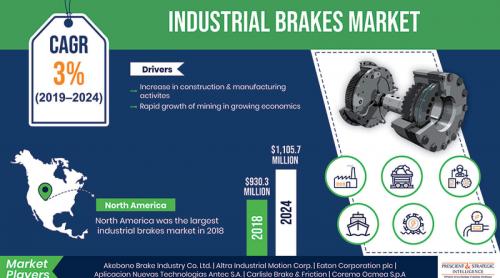Factory Automation Efforts Propelling Industrial Brakes Industry

The industrial brakes market is being driven by the increasing requirement for such devices in a wide range of sectors, which includes construction, manufacturing, oil and gas, and metal and mining. These factors are expected to propel the industry at a 3.0% CAGR during 2019–2024, which will lead to an increase in its size to $1,105.7 million by 2024 from $930.3 million in 2018. These devices are used to control the motion of cranes, packaging machines, wind turbines, construction machinery, metal and mining machines, tube machines, and marine and shipping machines.
Download report sample at: https://www.psmarketresearch.com/market-analysis/industrial-brakes-market/report-sample
Hydraulically applied brakes, mechanically applied brakes, electrically applied brakes, pneumatically applied brakes, and others are the different categories when the market is segmented based on type. Among these, the largest share during the historical period (2014–2018) was held by the hydraulically applied category. This is credited to the several advantages offered by brakes applied with the use of fluidic pressure, including cost-effectiveness, reliability, simple construction, uniform pressure transmission, long life, lightness, and ease of use.
The key driver for the industrial brakes market is the economic growth in developing countries. As the people of China, India, Brazil, and other emerging economies migrate to cities and experience a rise in their purchasing power, the demand for an array of products, from processed food to automobiles, will increase. This is leading to a strong competition among manufacturing companies, which is why they are installing braking solutions for a smoother and faster production process. Similarly, the growing construction industry is raising the sale of lifts, cranes, and other equipment, all of which need brakes.
Browse full report at: https://www.psmarketresearch.com/market-analysis/industrial-brakes-market
A lucrative opportunity area for the players in the industrial brakes market is the adoption of the industrial internet of things (IIoT). The Industry 4.0 revolution aims for the creation of smart factories with reduced energy consumption and automated operations. Here, brakes equipped with sensors are being used, with the sensors preventing any unauthorized movement of the machine, by leveraging artificial intelligence. Such brakes could also improve the working conditions, such as by stopping the movement of cranes carrying heavy stuff should anyone come below it.
Hence, the growing manufacturing industry due to government initiatives and rising purchasing power of the masses will propel the market for industrial brakes.
Advertise on APSense
This advertising space is available.
Post Your Ad Here
Post Your Ad Here
Comments